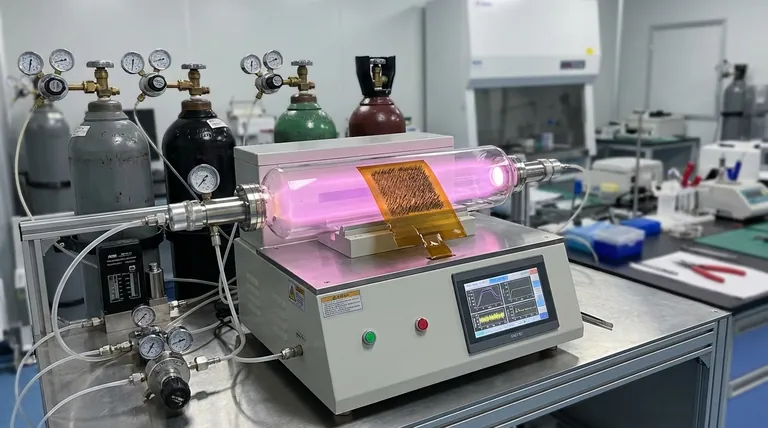In materials science, low-temperature growth of carbon nanotubes (CNTs) refers to any synthesis method, primarily Chemical Vapor Deposition (CVD), that operates significantly below the conventional range of 700-1000°C. These techniques aim to produce CNTs at temperatures between 300°C and 550°C. This is achieved not by simple heating, but by using alternative energy sources like plasma or more reactive chemicals to drive the necessary chemical reactions.
The central challenge in CNT synthesis is providing enough energy to break down carbon-source gases and activate a metal catalyst. While high heat is the traditional solution, low-temperature methods bypass this thermal requirement, unlocking the ability to grow CNTs directly on sensitive materials like plastics and integrated circuits.

The Barrier: Why High Temperatures are Standard
To understand low-temperature growth, we must first recognize why high temperatures are traditionally necessary. The process hinges on overcoming two critical energy barriers.
Energy for Precursor Decomposition
Standard carbon sources used in CVD, such as methane (CH₄) or acetylene (C₂H₂), are stable molecules. A significant amount of thermal energy is required to break their chemical bonds, a process known as pyrolysis, to release free carbon atoms for CNT formation.
Activation of the Metal Catalyst
Metal nanoparticles (typically iron, nickel, or cobalt) act as the seeds for CNT growth. At high temperatures, these particles become catalytically active, allowing them to absorb carbon atoms, reach a supersaturated state, and then precipitate the carbon in the form of a cylindrical graphene sheet—the nanotube.
Key Strategies for Lowering the Growth Temperature
Low-temperature techniques are clever workarounds that supply the required energy without heating the entire substrate to destructive levels.
Plasma-Enhanced CVD (PECVD)
This is the most common and effective method. Instead of relying solely on heat, an electric field is used to generate a plasma—an ionized gas containing highly reactive radicals and ions.
This plasma bombards the precursor gas molecules, forcefully breaking them apart at much lower substrate temperatures. The energy for the reaction comes from the electric field, not from thermal vibration.
Alcohol Catalytic CVD (ACCVD)
This method uses alcohols, such as ethanol or methanol, as the carbon source. Alcohols decompose at lower temperatures compared to hydrocarbons like methane.
Furthermore, the hydroxyl (-OH) group present in alcohols can act as a weak oxidizing agent. This helps to etch away unwanted amorphous carbon byproducts, resulting in higher-purity CNTs even at reduced temperatures.
Advanced Catalyst Engineering
Research focuses on creating catalyst systems that are more active at lower temperatures. This can involve using specific metal alloys or depositing the catalyst particles on a specialized support layer that enhances their chemical reactivity, reducing the energy needed to initiate growth.
Understanding the Trade-offs
Lowering the synthesis temperature is not a free lunch. It introduces critical trade-offs that must be considered for any practical application.
The Challenge of Structural Quality
The biggest trade-off is often CNT quality. The lower kinetic energy available during growth can result in more structural defects in the nanotube's hexagonal lattice. High-temperature growth generally produces more crystalline, highly ordered, and therefore more conductive CNTs.
Slower Growth Rates
Chemical reactions slow down at lower temperatures. Consequently, low-temperature processes can have significantly lower growth rates, impacting throughput and manufacturing efficiency.
Controlling Amorphous Carbon
While methods like ACCVD help, incomplete decomposition of the carbon source at lower temperatures can lead to the deposition of undesirable, non-crystalline amorphous carbon. This byproduct can coat the catalyst, deactivating it, and can degrade the electrical properties of the final CNT film.
Making the Right Choice for Your Goal
The choice between high- and low-temperature synthesis is dictated entirely by the end-use application and, most importantly, the substrate you are using.
- If your primary focus is maximum structural perfection and conductivity for applications like bulk composites or conductive additives, traditional high-temperature CVD on a robust substrate remains the superior choice.
- If your primary focus is direct integration with temperature-sensitive electronics like CMOS wafers (which are damaged above ~450°C), low-temperature PECVD is the essential enabling technology.
- If your primary focus is creating flexible electronics on polymer substrates like polyimide, a low-temperature method is non-negotiable, as the plastic would be destroyed by conventional processes.
Ultimately, mastering CNT growth is about selecting the right tool to overcome the energy barrier for your specific material and integration challenge.
Summary Table:
| Aspect | High-Temp CVD | Low-Temp CVD |
|---|---|---|
| Typical Temperature | 700-1000°C | 300-550°C |
| Primary Method | Thermal CVD | Plasma-Enhanced CVD (PECVD) |
| Best For Substrates | Silicon, Ceramics, Metals | Plastics, CMOS Wafers, Flexible Electronics |
| CNT Quality | High Crystallinity, Fewer Defects | Potential for More Defects |
| Key Advantage | Superior Electrical Properties | Direct Integration with Sensitive Materials |
Ready to integrate carbon nanotubes into your temperature-sensitive devices? KINTEK specializes in lab equipment and consumables for advanced materials synthesis, including systems tailored for low-temperature CNT growth. Our expertise can help you overcome the challenges of substrate compatibility and achieve high-quality results. Contact our experts today to discuss your specific application needs!
Visual Guide

Related Products
- Customer Made Versatile CVD Tube Furnace Chemical Vapor Deposition Chamber System Equipment
- Split Chamber CVD Tube Furnace with Vacuum Station Chemical Vapor Deposition System Equipment Machine
- Laboratory Quartz Tube Furnace Tubular RTP Heating Furnace
- Rotary Tube Furnace Split Multi Heating Zone Rotating Tube Furnace
- Vertical Laboratory Quartz Tube Furnace Tubular Furnace
People Also Ask
- What is the floating catalyst method? A Guide to High-Yield CNT Production
- What is a CVD tube furnace? A Complete Guide to Thin-Film Deposition
- Are all lab grown diamonds CVD? Understanding the Two Main Methods
- How high of temperature do carbon nanotubes in air have the ability to sustain? Understanding the Oxidation Limit
- What are nanotubes drawbacks? The 4 Major Hurdles Limiting Their Real-World Use



















